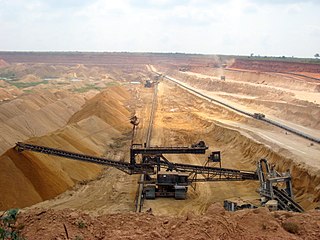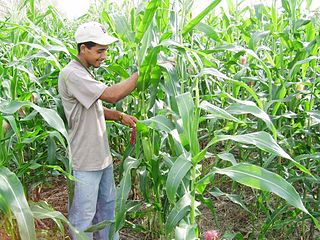Related Research Articles

The economy of Gabon is characterized by strong links with France, large foreign investments, dependence on skilled foreign labor, and decline of agriculture. Gabon enjoys a per capita income four times that of most nations of sub-Saharan Africa, its reliance on resource extraction industry releasing much of the population from extreme poverty.

The economy of Togo has struggled greatly. The International Monetary Fund (IMF) ranks it as the tenth poorest country in the world, with development undercut by political instability, lowered commodity prices, and external debts. While industry and services play a role, the economy is dependent on subsistence agriculture, with industrialization and regional banking suffering major setbacks.

Agriculture in Thailand is highly competitive, diversified and specialized and its exports are very successful internationally. Rice is the country's most important crop, with some 60 percent of Thailand's 13 million farmers growing it on fully half of Thailand's cultivated land. Thailand is a major exporter in the world rice market. Rice exports in 2014 amounted to 1.3 percent of GDP. Agricultural production as a whole accounts for an estimated 9-10.5 percent of Thai GDP. Forty percent of the population work in agriculture-related jobs. The farmland they work was valued at US$2,945 per rai in 2013. Most Thai farmers own fewer than eight hectares of land.

Agriculture in Nigeria is a branch of the economy in Nigeria, providing employment for about 35% of the population as of 2020. As reported by the FAO, agriculture remains the foundation of the Nigerian economy, despite the presence of oil in the country. It is the main source of livelihood for most Nigerians. The Agricultural sector is made up of four sub-sectors: Crop Production, Livestock, Forestry and Fishing. In the third quarter of 2019, the sector grew by 14.88% year-on-year in nominal terms with a decline of 3.44% points from the third quarter of 2018. The largest driver of the sector remains Crop Production as it accounts for 91.6% of the sector in the third quarter of 2019 with a quarterly growth which stood at 44.12%. The Agriculture sector contributed 29.25% to overall real GDP during the third quarter of 2019.

Agriculture is one of the dominant parts of Senegal's economy. Even though Senegal lies within the drought-prone Sahel region, only about 5 percent of the land irrigated, thus Senegal continues to rely on rain-fed agriculture. Agriculture occupies about 75 percent of the workforce. Despite a relatively wide variety of agricultural production, the majority of farmers produce for subsistence needs. Millet, rice, corn, and sorghum are the primary food crops grown in Senegal. Production is subject to drought and threats of pests such as locusts, birds, fruit flies, and white flies. Moreover, the effects of climate change in Senegal are expected to severely harm the agricultural economy due to extreme weather such as drought, as well as increased temperatures.

Agriculture in Colombia refers to all agricultural activities, essential to food, feed, and fiber production, including all techniques for raising and processing livestock within the Republic of Colombia. Plant cultivation and livestock production have continuously abandoned subsistence agricultural practices in favour of technological farming resulting in cash crops which contribute to the economy of Colombia. The Colombian agricultural production has significant gaps in domestic and/or international human and animal sustenance needs.

Agriculture in Ghana consists of a variety of agricultural products and is an established economic sector, and provides employment on a formal and informal basis. Ghana produces a variety of crops in various climatic zones which range from dry savanna to wet forest and which run in east–west bands across Ghana. Agricultural crops, including yams, grains, cocoa, oil palms, kola nuts, and timber, form the base of agriculture in Ghana's economy. In 2013 agriculture employed 53.6% of the total labor force in Ghana.
Agriculture continued to be the mainstay of the economy of Haiti in the late 1980s; it employed approximately 66 percent of the labor force and accounted for about 35 percent of GDP and for 24 percent of exports in 1987. The role of agriculture in the economy has declined severely since the 1950s, when the sector employed 80 percent of the labor force, represented 50 percent of GDP, and contributed 90 percent of exports. Many factors have contributed to this decline. Some of the major ones included the continuing fragmentation of landholdings, low levels of agricultural technology, migration out of rural areas, insecure land tenure, a lack of capital investment, high commodity taxes, the low productivity of undernourished animals, plant diseases, and inadequate infrastructure. Neither the government nor the private sector invested much in rural ventures; in FY 1989 only 5 percent of the national budget went to the Ministry of Agriculture, Natural Resources, and Rural Development. As Haiti entered the 1990s, however, the main challenge to agriculture was not economic, but ecological. Extreme deforestation, soil erosion, droughts, flooding, and the ravages of other natural disasters had all led to a critical environmental situation.

Agriculture employs the majority of Madagascar's population. Mainly involving smallholders, agriculture has seen different levels of state organisation, shifting from state control to a liberalized sector.

Benin is predominantly a rural society, and agriculture in Benin supports more than 70% of the population. Agriculture contributes around 35% of the country's gross domestic product (GDP) and 80% of export income. While the Government of Benin (GOB) aims to diversify its agricultural production, Benin remains underdeveloped, and its economy is underpinned by subsistence agriculture. Approximately 93% of total agricultural production goes into food production. The proportion of the population living in poverty is about 35.2%, with more rural households in poverty (38.4%) than urban households (29.8%). 36% of households depend solely upon agricultural (crop) production for income, and another 30% depend on crop production, livestock, or fishing for income.
About 90 percent of the population (Burundi) depends on agriculture for a living. Most agriculture consists of subsistence farming, with only about 15% of the total production marketed. An estimated 1,351,000 hectares (3,338,000 acres), or about 52.6% of the total land area, is arable or under permanent crops; about 5.5% of cropland is irrigated. The average farm family plot is 0.8 hectares. Agriculture accounted for 51% of the GDP in 2004. Coffee and tea exports comprise the majority of foreign earnings; coffee alone accounted for 39% of exports of goods in 2004. Agricultural exports accounted for 48 percent of exports in 2004. Principal crops for local consumption are manioc, beans, bananas, sweet potatoes, corn, and sorghum. Production in 2004 included bananas, 1,600,000 tons, mostly for wine; manioc, 710,000 tons; sweet potatoes, 834,000 tons; beans, 220,000 tons; sorghum, 74,000 tons; corn, 123,000 tons; peanuts, 8,800 tons; and yams, 9,900 tons.
Agriculture in Cameroon is an industry that has plenty of potential.
Agriculture in Cape Verde is an industry that has plenty of potential.

The economy of Ivory Coast is stable and currently growing, in the aftermath of political instability in recent decades. The Ivory Coast is largely market-based and depends heavily on the agricultural sector. Almost 70% of the Ivorian people are engaged in some form of agricultural activity. GDP per capita grew 82% in the 1960s, reaching a peak growth of 360% in the 1970s. But this proved unsustainable and it shrank by 28% in the 1980s and a further 22% in the 1990s. This coupled with high population growth resulted in a steady fall in living standards. Gross national product per capita, now rising again, was about US$727 in 1996.

The role of agriculture in the Bolivian economy in the late 1980s expanded as the collapse of the tin industry forced the country to diversify its productive and export base. Agricultural production as a share of GDP was approximately 23 percent in 1987, compared with 30 percent in 1960 and a low of just under 17 percent in 1979. The recession of the 1980s, along with unfavorable weather conditions, particularly droughts and floods, hampered output. Agriculture employed about 46 percent of the country's labor force in 1987. Most production, with the exception of coca, focused on the domestic market and self-sufficiency in food. Agricultural exports accounted for only about 15 percent of total exports in the late 1980s, depending on weather conditions and commodity prices for agricultural goods, hydrocarbons, and minerals.

Agriculture in Jordan contributed substantially to the economy at the time of Jordan's independence, but it subsequently suffered a decades-long steady decline. In the early 1950s, agriculture constituted almost 40 percent of GNP; on the eve of the June 1967 War, it was 17 percent.

Agriculture in Panama is an important sector of the Panamanian economy. Major agricultural products include bananas, cocoa beans, coffee, coconuts, timber, beef, chicken, shrimp, corn, potatoes, rice, soybeans, and sugar cane.

Agriculture in Spain is important to the national economy. The primary sector activities accounting for agriculture, husbandry, fishing and silviculture represented a 2.7% of the Spanish GDP in 2017, with an additional 2.5 % represented by the agrofood industry.

Despite the low rainfall and poor soil, agriculture in Bahrain historically was an important sector of the economy. Before the development of the oil industry, date palm cultivation dominated Bahrain's agriculture, producing sufficient dates for both domestic consumption and export. At least twenty-three varieties of dates are grown, and the leaves, branches, buds, and flowers of the date palm also are used extensively. From the 1950s through the 1970s, changing food consumption habits, as well as the increasing salinity of the aquifers that served as irrigation sources, led to a gradual decline in date cultivation. By the 1980s, a significant number of palm groves had been replaced by new kinds of agricultural activities, including vegetable gardens, nurseries for trees and flowers, poultry production, and dairy farms.

Agriculture in the Democratic Republic of the Congo is an industry in the country of the Democratic Republic of the Congo that has plenty of potential.
References
This article includes a list of general references, but it remains largely unverified because it lacks sufficient corresponding inline citations .(July 2009) (Learn how and when to remove this template message) |
![]() This article incorporates public domain material from the Library of Congress Country Studies website http://lcweb2.loc.gov/frd/cs/ .
This article incorporates public domain material from the Library of Congress Country Studies website http://lcweb2.loc.gov/frd/cs/ .
